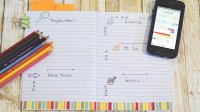Smart Strategies for Student Success
Five techniques you can use with students in any class to help boost their long-term learning outcomes.
Your content has been saved!
Go to My Saved Content.Even students who’ve had years of active involvement in learning activities don’t automatically use strategies that best foster learning. However, working smarter through the use of specific success strategies can have a profound influence on learning outcomes. In this article, we share practical strategies teachers can use with students to help them learn smarter and with greater independence.
Explain It to Your Brain
One creative way for teachers to help to get students engaged in the process of developing effective learning strategies is to apply a metaphor we call “explain it to your brain.” Students who use self-explanation tell themselves what they are thinking and doing when learning. This strategy is closely related to metacognition, a characteristic of successful student learning and of professional success across careers.
A favorite way to teach this skill is by modeling self-explanation aloud across contexts in the classroom. For example, when working at the board in math class, you might pose a question like, “How might I solve this algebra problem?” Then you could begin to talk through the problem aloud so that students can learn from your modeling how to engage in self-dialogue when problem solving, reading, or performing other learning tasks. After students have experienced your modeling across various examples, give them opportunities to use this strategy aloud too. Over time, the goal is for students to use this tool silently and independently.
A number of important cognitive strategies are involved in the process of self-explanation, including integrating new information with prior knowledge, generating inferences when there’s missing information, and monitoring and fixing faulty knowledge. Students can self-explain when they problem solve as a way to help them decide how to proceed.
Take Brain Breaks While Learning
When students sit in one place trying to remain focused on instruction for too long, it makes learning difficult. The result can be lethargy, boredom, or acting-out behavior. Facilitate active engagement in learning by giving students an opportunity to move by taking short two- to five-minute breaks every 20 minutes or so during class time. This can help to get more oxygen to the brain. An example of a short brain break might be for students to stand up, find a partner, and take turns sharing something they have just learned. Another example is for teachers of students of all ages to lead a couple rounds of jumping jacks or running in place. PE teachers are great resources for providing suggestions for integrating movement into the classroom.
Self-Test for Success
Teaching students how to test themselves will provide them with one of the most powerful tools for reinforcing their learning. A simple, proven way to guide students to self-test is through the use of index cards. Ask them to decide: What questions do you think your teacher would include on a test or exam? Instruct them to create a list of the best questions they can think of—have them write each question on an index card and to put the answers on the back. It’s best to use pencils with erasers, using different colored cards for different classes. Students who want more variety can use colored pencils.
Show students how to create an authentic practice test by:
- selecting the same number of questions as will be on the test,
- allowing the same amount of time for answering the practice questions as they will have at test time, and
- finishing by checking their answers.
It’s good to use this strategy throughout the school year to give students practice. Especially the first few times this strategy is used, check over the cards after students have created them and give students feedback as necessary until they’ve learned the process.
Make Schedules and Pace Your Practice
Encourage students to create a study planner to build in time for going to class and the library, as well as for study sessions for distributed practice over time to avoid cramming immediately before test time. Some students (including younger ones) will need assistance setting up their planner and inspiration to use it. As students learn more new material than they thought possible, they’ll be motivated by their successes. It’s a good idea to advise students to plan in extra time, in case tasks take longer than expected, and to read ahead when possible.
Teachers can also help students with distributed practice when they build in multiple periods of classroom instruction with a focus on the most important material to be learned. A good rule of thumb to remember: The brain needs at least seven to nine repeated exposures over time before new content is learned.
Teach It to a Friend
Emotions that are stimulated when students have an opportunity to teach what they’ve recently learned may create greater knowledge and memory. When teachers tell their students before a lesson that they will need to prepare to teach what they learn, pupils tend to work harder to understand the material, search for the main points, organize and apply knowledge more effectively, and score higher on tests. Researchers call these findings “the protégé effect.”
We have found it works best to set up teaching pairs and allow each partner to have a chance to teach the other a part of the lesson. Teachers of elementary-aged children can ask them to tutor those younger than themselves.
